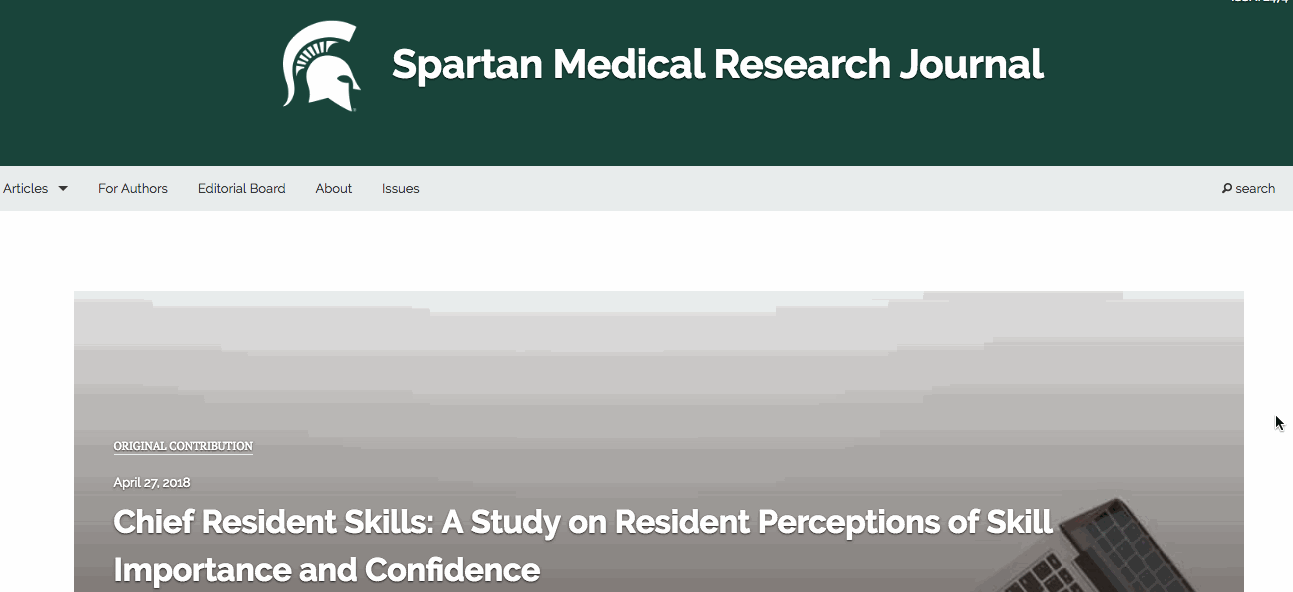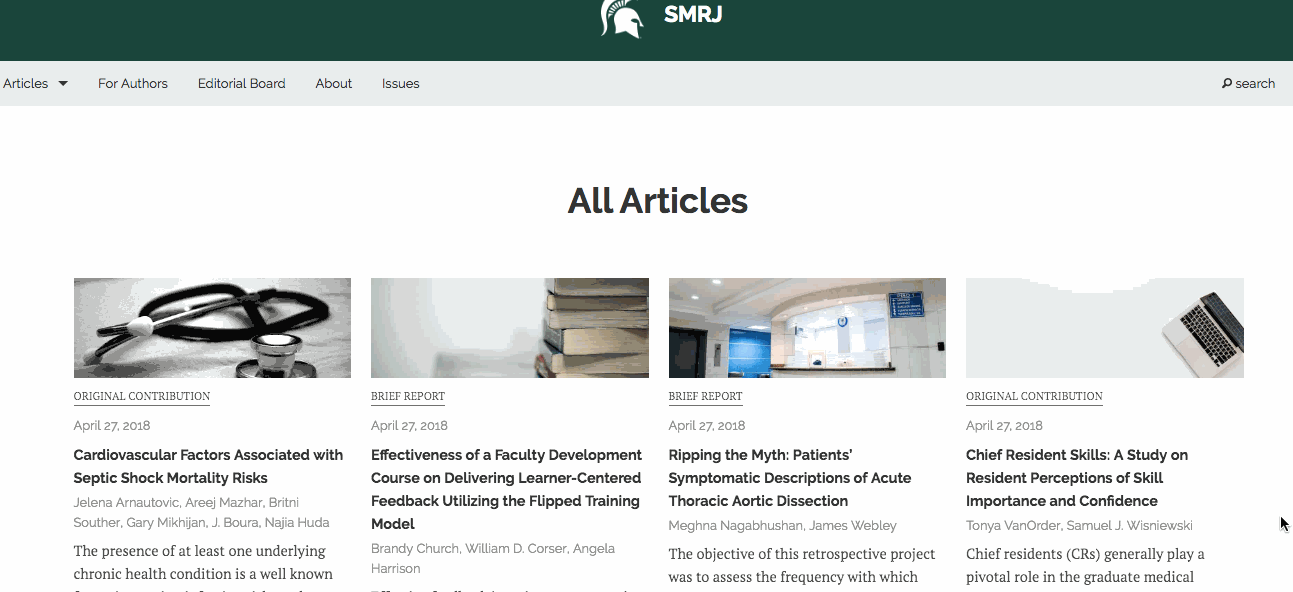
Since 2016, the Spartan Medical Research Journal (SMRJ) has served as a formal publication outlet for research completed by students, residents, and faculty at the Michigan State University College of Osteopathic Medicine (MSUCOM). Now entering its sixth volume, the journal’s mission remains to publish timely peer-reviewed articles on quality improvement and patient safety, clinical, and medical education research that will lead to improved patient care and teaching outcomes.
When SMRJ started, the editors used email and Word docs to track submissions, and they published all articles in PDF format. However, as the journal grew, the editors realized they needed an easier way to track peer review, and that they would have to start producing machine-readable article files to be eligible for inclusion in major indexes. They also wanted to improve SMRJ’s online reading experience and search engine performance. As a result, Chief Editor William Corser and Assistant Editor Sam Wisniewski began searching for publishing tools and services, focused on three key areas: streamlining peer review, modernizing the journal’s website, and producing XML for all articles.
After considering different options, Corser and Wisniewski chose to use Scholastica’s Peer Review System and Open Access Publishing Platform, as well as Scholastica’s digital-first Production Service to produce PDF, HTML, and full-text XML article files with rich metadata. Since transitioning to Scholastica, SMRJ has found that peer review is smoother for editors, authors, and reviewers, and they have a better online reading experience and indexing.

A growing medical publication
Over the years, SMRJ’s team has been developing the journal to better serve the needs of authors and readers at MSUCOM and beyond. The publication has proven to be a prime example of how university departments can launch journals to add value to their research communities.
“I think the dean kind of points to us as a good example of what departments can do. We’re meeting a need by providing a place for students, residents, and faculty to publish their work. There is certainly a lot more work done than actually gets out there,” said Corser.
The SMRJ team has consistently seen the fruits of its efforts to reach more authors and publish articles on diverse topics. As of February 2019, Corser said, “we’re starting to see greater variety in articles published. I would say about 20% of our papers are case reports, and then I think we have about 50% research papers and 30% quality improvement papers. Most of our articles are coming from within the MSUCOM community, but some are from outside folks who found us online or heard about us via word of mouth, which is positive.”
With their exciting journal growth, SMRJ’s editors began to recognize new internal and external needs both in terms of managing peer review and online publishing. “It’s just the two of us handling the submissions coming in and getting them back and forth to peer reviewers. Relying on email and Word docs was getting pretty difficult,” explained Wisniewski. “So we started talking about ways to streamline that process. At the same time, we were getting our PubMed Central indexing application ready to submit to be searchable in PubMed, and that’s when we realized we needed XML. So it was really good timing when we found Scholastica and realized it could help us with all of those things.”
More streamlined peer review for editors and authors
Since transitioning to Scholastica software, Corser and Wisniewski say SMRJ’s peer review workflow has improved. “From what we’ve seen, the same kind of streamlining we’re seeing on our end seems to be happening for the authors in terms of peer review — everything has been great. It’s been especially helpful to have a way to have conversations back and forth within Scholastica with authors,” said Wisniewski.
Corser said he also hopes using Scholastica for peer review will help improve the manuscript preparation quality of SMRJ submissions. “The online submission system obliges authors to fill in some qualifying fields, and we’re hoping that’s going to improve our efficiency by helping us get better-prepared submissions,” he explained. “When we just got stuff emailed to us, it could be quite a mess. We’d often have to send authors copies of our Instructions for Authors file because they didn’t follow them, and the results were pretty mixed in terms of whether authors followed through on making necessary updates. I think the submission software helps make it clear to authors that they can’t successfully submit something without following certain steps.”
New publishing and indexing opportunities and plans for the future

Corser and Wisniewski said Scholastica’s publishing software and production service are also helping them to improve SMRJ’s reader experience and indexing.
Since moving to Scholastica, SMRJ has been admitted to PubMed Central and PubMed search, and the journal now uses Scholastica’s PMC integration to automate its full-text XML article deposits. “XML formatting is pretty much required for PMC, and that’s one thing that we weren’t going to be able to do ourselves,” Said Corser. “With Scholastica’s formatting, articles are also looking fancier, and they are more interactive for readers than before. You can click on citations, and they pull up the reference, you have nicer graphics, and the journal looks more polished overall.”
SMRJ’s editors hope to keep attracting new readers and more quality submissions as the journal grows. “We’re mostly looking for original contributions and quality improvement and patient safety projects. We aim to continue getting more diverse article types and content,” said Wisniewski.
Corser noted that the journal is already lucky in having a wide range of submissions to choose from. “It’s really positive that we are not desperate to accept anything that rolls in. We are afforded the luxury of being able to be increasingly picky about what we accept,” he said.
Corser and Wisniewski both believe SMRJ is filling a greater need by providing an open access publishing platform for the MSUCOM community and beyond. “We have heard from authors that they are delighted Google Scholar is indexing their articles and that anyone in the world can access them,” said Corser. “We’re hoping that publishing on Scholastica will help us expose the journal to even more authors and readers as an OA publishing option.”
Update Note: This post was originally published on February 27, 2019 and updated on December 9, 2021.








![Scholastica OA Journal Publishing Platform Overview: hosting, indexing, and analytics in one place [latest features]](https://i.imgur.com/23hAPvpm.png?1)